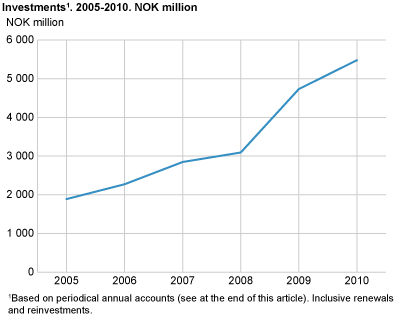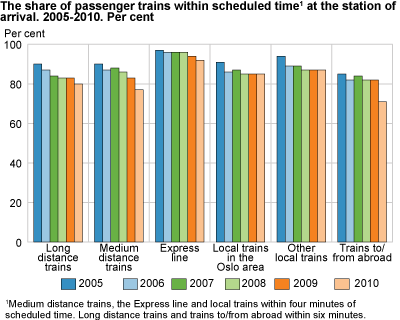Content
Published:
This is an archived release.
A tripling of investments
The total investments of the Norwegian National Rail Administration constituted almost NOK 5.5 billion in 2010. This is an increase of 190 per cent compared to 2008 and 16 per cent from 2009.
The yearly increase in government investments in the rail network came to NOK 400 million on average for 2005-2008. The following year the increase came to NOK 1.6 billion, and from 2009 to 2010 there was an increase of NOK 750 million to almost NOK 5.5 billion including renewals and reinvestments.
Simultaneously with the considerable increase in investments, the operating expenditures increased. These costs constituted NOK 3.2 billion in 2005 and had increased to NOK 4.9 billion in 2010. This was in increase of 50 per cent.
NOK 3.8 billion spent on maintenance and upgrading of the infrastructure
The costs spent on the maintenance and upgrading of the infrastructure came to NOK 3.8 billion including depreciation in 2010. Of this, NOK 1.7 billion related to the maintenance and upgrading of railway lines. This was an increase of NOK 240 million compared to 2009. Signalling/interlockings and electrification were other considerable items for maintenance, with about NOK 800 million in total in 2010.
Despite increased expenditures, less trains in accordance with schedule ...
The statistics show a fall in punctuality from 2005 to 2010 for all types of train. The Gardermoen line had the decidedly highest punctuality also in 2010. Eight per cent of the trains on this track did not arrive at the final railway station within four minutes of the announced timetable. Although the express airport train had the highest punctuality, this fell 2 percentage points from 2009 to 2010 as it did the previous year. Though the limit for arrival is increased to within six minutes, it is still the trains from abroad that are most frequently delayed at the final railway station. Twenty-nine per cent of these trains were delayed in 2010; 11 percentage points above the corresponding 2009 figure.
... and more hours of dead time
Almost 12 000 hours of dead time for both passenger and goods train were caused by incidents related to infrastructure and other conditions in 2010. This was an increase of 1 700 hours compared to 2009.
Fewer level crossings and some more passing loops
The number of level crossings has been gradually reduced in recent years in accordance with the goal stated in the National plan for transport. In 2010, there were 3 601 such crossings; a reduction of 12 per cent compared to 2005. With a percentage of double tracks of only 6 per cent, there is a need for passing loops for flexible traffic organisation. Nevertheless, the statistics show an increase of only five passing loops from 2009 to 2010. All of these passing loops were less than 600 metres.
Public railway operationRailway infrastructure administratorUntil 1996, both the administration of the railway infrastructure and train transport were placed under the public management company Norwegian State Railways. This company was subsequently split in two: The administrative body Norwegian National Rail Administration and the public-owned company Norwegian State Railways plc (which changed to a private limited company in July 2002). Norwegian National Rail Administration is responsible for administrating the railway infrastructure, the operational management of trains and assigning routes. The enterprise was included in StatRes in 2008. AllocationsThe activity of the Norwegian National Rail Administration is entirely based on governmental allocations. Periodical annual accountsIn addition to keeping the normal cash flow accounting, the Norwegian National Rail Administration also delivers periodic annual accounts for public enterprises. The Norwegian National Rail Administration has kept such accounts since 2005 based on the standards developed for these types of accounts. The figures referred to in this article are in accordance with the periodical annual accounts. In cash flow accounting, the expenditures and earnings are reported on the settlement date, while in periodic accounts the expenditures are charged when they are incurred and the revenues when they are earned. |
What is StatRes?The governmental activity within administrating the railway infrastructure, the operational management of trains and assigning routes form part of StatRes - State resource use and results. The purpose of StatRes is to show the level of resources that the state uses, what this input provides in terms of activities and services in the various government activities, and what outcomes can be seen from the input. Its aim is to provide the general public and the authorities with more knowledge of state-run activities. |
Find more figures
Also find statistics about the quality of the track, number of stations, platforms, tunnels and bridges.
Additional information
The statistics give an overview of the amount of resources the Norwegian National Rail Administration spends on administrating the infrastructure, the operational management of trains and assigning routes, and the results of the effort.
Contact
-
Statistics Norway's Information Centre
E-mail: informasjon@ssb.no
tel.: (+47) 21 09 46 42


